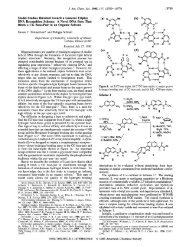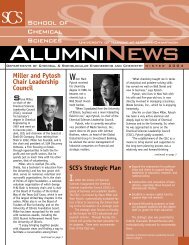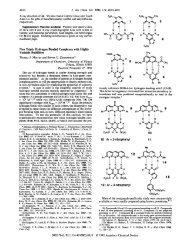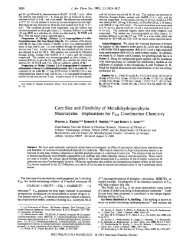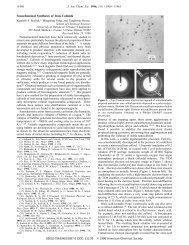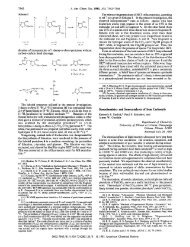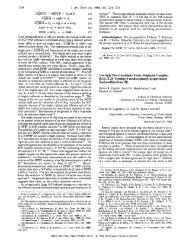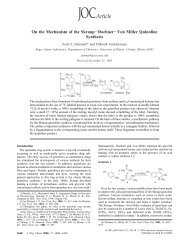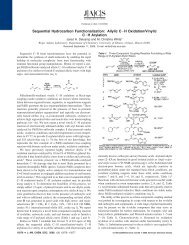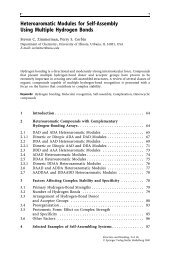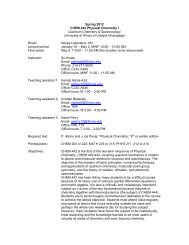Download PDF - Whitesides Research Group - Harvard University
Download PDF - Whitesides Research Group - Harvard University
Download PDF - Whitesides Research Group - Harvard University
Create successful ePaper yourself
Turn your PDF publications into a flip-book with our unique Google optimized e-Paper software.
Fabrication inside Microchannels Using Fluid Flow<br />
Kenis et al.<br />
FIGURE 6. Examples of biologically relevant patterns generated<br />
using multiphase laminar flow. (A) Top view of a capillary network<br />
used for biological patterning. Optical micrographs B-D (fluorescence)<br />
represent close-up views of the junctions where the inlets<br />
converge into a single main channel. (B) Creating patterns of proteins<br />
inside a capillary. Solutions of bovine serum albumin (BSA) and BSA<br />
colabeled with mannose and fluorescein (man-FITC-BSA) were<br />
allowed to flow through the designated channels. (C) Patterned<br />
deposition of cells inside a capillary. Chick erythrocytes and<br />
Escherichia coli were deposited selectively in their designated lanes<br />
by patterned flow of cell suspensions. Adherent cells were visualized<br />
with a fluorescent nucleic acid stain (Syto 9). (D) Using patterned<br />
flow of media to stain part of the bovine capillary endothelial cells<br />
that were attached to the entire bottom face of a capillary. Only<br />
those cells over which a solution of dye (Syto 9) was allowed to<br />
flow were labeled. Syto 9 and media were allowed to flow from the<br />
designated inlets.<br />
they can form; photolithography is a very general method<br />
of forming patterns.<br />
The occurrence of laminar flow on the microscopic<br />
scale allows liquid streams to be maintained as entities<br />
that are separate and capable of delivering different<br />
reagents. The width of the separate streams (or the<br />
interfacial width as governed by the rates of diffusion)<br />
internal to the channel determines the feature sizes, and<br />
the relative volumes of the streams control the position<br />
of the liquid-liquid interfaces. External positioning tools<br />
or masks determine feature sizes and positions in photolithography.<br />
The usual problem in microfabrication<br />
based on photolithography of determining position in<br />
superimposing patterns in multilayer fabrication (registration)<br />
translates into a problem of controlling relative rates<br />
of flow in microfluidic fabrication.<br />
Microfluidic and photolithographic patterning are sufficiently<br />
different in the physical principles on which they<br />
rest that they are complementary in their applications.<br />
Fluidic microfabrication inside capillaries is presently best<br />
suited for one-at-a-time, research, or prototyping demonstrations.<br />
Its strengths are convergence, specific applicability<br />
to problems involving channels (e.g., microanalytical<br />
devices), and compatibility with biological reagents<br />
and systems. Photolithography is highly developed for inplane<br />
microfabrication and can be used to make many<br />
devices in parallel. Its strengths are generality in patterning,<br />
the ability to make small features, the ability to<br />
manufacture small systems in large numbers, and performance<br />
highly optimized for use with semiconductors<br />
and ceramics.<br />
Fluid flow in microchannels allows the fabrication of<br />
a variety of useful structures ranging from conducting<br />
organic fibers to electrode systems integrated into microanalytical<br />
devices. Fluid flow also has the ability to<br />
deposit or carve away material on the interior surface of<br />
the capillary, and thus to change the surface properties<br />
or topography of a channel. Such patterns can have a<br />
profound effect on the flow profiles. For example, electroosmotic<br />
flow in capillaries that are patterned with regions<br />
of opposite surface charge leads to unusual low-Re flows. 25<br />
Studies of the details of the fluid flow in microfluidic<br />
systemssby visualization or modelingsshould make it<br />
possible to fabricate a broader range of structures using<br />
fluid flow. 26<br />
Fluid flows have clear potential to pattern delicate<br />
biological structures. They are also applicable to patterning<br />
the topography of the surfaces, the proteins absorbed<br />
on these surfaces, cells attached to those surfaces, and<br />
the medium to which the cells are exposed. We expect<br />
these methods to facilitate the study of, for example, cellsurface<br />
adhesion, chemotaxis, and cell-cell communication,<br />
and to contribute to cell-based microfluidic sensors.<br />
The work at <strong>Harvard</strong> was supported financially by DARPA<br />
through NSF Grant ECS-97294505, and MRSEC-shared facilities<br />
supported by the NSF under Grant NSF DMR-9809363 were used.<br />
Work at the <strong>University</strong> of Utah was supported by the Office of<br />
Naval <strong>Research</strong>. P.J.A.K. acknowledges the Netherlands Organization<br />
for Scientific <strong>Research</strong> (NWO) for a postdoctoral fellowship.<br />
S.T. thanks the Leukemia and Lymphoma Society for a postdoctoral<br />
fellowship.<br />
References<br />
(1) Duffy, D. C.; McDonald, J. C.; Schueller, O. J. A.; <strong>Whitesides</strong>, G.<br />
M. Rapid Prototyping of Microfluidic Systems in Poly(dimethylsiloxane).<br />
Anal. Chem. 1998, 70, 4974-4984.<br />
(2) Madou, M. Fundamentals of Microfabrication; CRC Press: New<br />
York, 1997.<br />
(3) Matsuura, Y.; Miura, D.; Miyagi, M. Fabrication of Copper Oxide-<br />
Coated Hollow Waveguides for CO 2 Laser Radiation. Appl. Opt.<br />
1999, 38, 1700-1703.<br />
(4) Renn, M. J.; Pastel, R. Particle Manipulation and Surface Patterning<br />
by Laser Guidance. J. Vac. Sci. Technol. B. 1998, 16, 3859-<br />
3863.<br />
(5) The characteristics of fluid flow in capillaries have been studied<br />
extensively in the past. See, for example: Rosenhead, L. Laminar<br />
Boundary Layers; Dover Publications: New York, 1988. Tritton,<br />
D. J. Physical Fluid Dynamics, 2nd ed.; Oxford <strong>University</strong> Press:<br />
New York, 1988.<br />
846 ACCOUNTS OF CHEMICAL RESEARCH / VOL. 33, NO. 12, 2000



